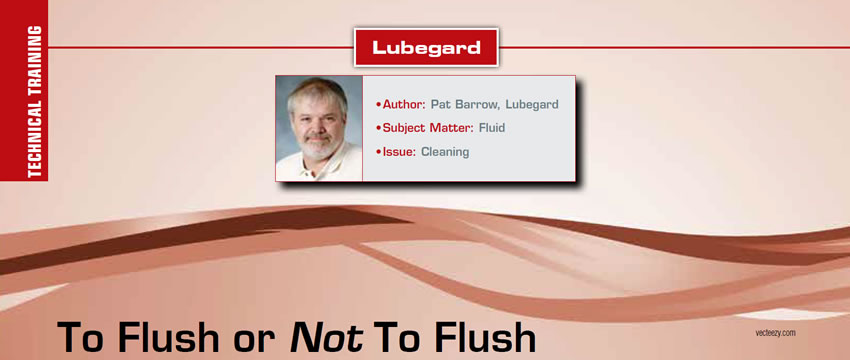
Technical Training
- Author: Pat Barrow, Lubegard
- Subject Matter: Fluid
- Issue: Cleaning
One of the major issues that often gets overlooked when removing and replacing an automatic or CVT transmission is the removal of contaminated or old transmission fluid from the transmission cooler and lines. Contaminated cooling systems for automatic transmissions (usually mounted in the bottom of the same radiator that cools your engine) are often the cause of pre-mature failure of replacement trans-missions. This is because they are not properly cleaned and purged of used transmission fluid full of contamination and debris from the transmission that previously failed. There are several ways this can be accomplished with pros and cons for each method. Knowing not every shop or installer has a hot flush machine to clean coolers and heat exchangers, the need for an effective cleaning solution is apparent. The method for removal of this used oil and contamination has provided technicians and DIY mechanics a compact portable and effective method to accomplish this necessary task. This flushing solution is an aerosol can, containing a safe non-aqueous flush with an easily attached hose. It is designed to provide a safe, convenient and effective solution for removal of the used automatic transmission fluid and the contamination it contains from external heat exchangers and radiator mounted coolers.
The goal is to prevent new or rebuilt transmissions from becoming contaminated with used fluid. In addition to dirty depleted trans-mission fluid the cooler and lines are often contaminated with dirt, grease, sludge, clutch material, metals shavings and particles that will quickly destroy the expensive new or rebuilt transmission you just so carefully installed. If the transmission failed catastrophically (internals came apart in a very destructive way that filled the transmission with metal) it may not be possible to remove all the debris, no matter what method of cleaning you select-ed. Some models of new and rebuilt transmissions come with a new radiator or external cooler that you are required to use or the warranty on that transmission is void. Some transmission suppliers even want you to return the used radiator with your transmission core for the full warranty to be in effect.
Many transmission failures are the result of solenoids or seals and clutches failure (or in the case of CVT transmissions, belts and sheaves) that do not fill the trans-mission fluid with contaminates and metals that would normally require the replacement of the radiator or cooler for the transmission. These cooling systems in fact need only to be purged of the used automatic transmission fluid and any dirt and contamination that might have accumulated. That is when the aerosol line and flush cleaner become a necessary, convenient and cost-effective solution for the problem. Often included by OEM’s and aftermarket transmission re-builders when they sell a remanufactured or used automatic transmission or CVT transmission, the aerosol line flusher is formulated to not harm seals or degrade new transmission fluid and will prevent costly come-backs.
Aerosol line flush is often used to assess the extent of the contamination by catching the oil and flush in a clear container and evaluating contamination level of the removed fluid. If a large volume of metal and contamination is in the used ATF and flush, it may be necessary to replace the radiator or cooler to avoid future problems such as trapped materials coming loose down the road. If there is little or no contamination, installation of an inline transmission filter on the low-pressure transmission fluid re-turn line that runs from the radiator or heat exchanger back to the trans-mission will provide an added level of protection from contamination getting into the new or replacement transmission.
The bottom line is that the aerosol line flush available today provides the installer or DIY mechanic with a cleaning option that is inexpensive, safe, portable and reliable when used as directed.














